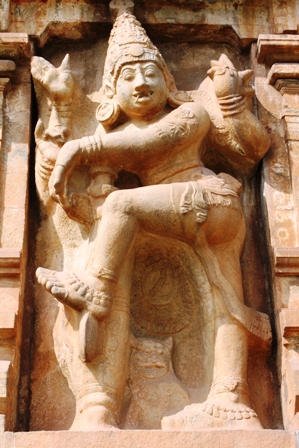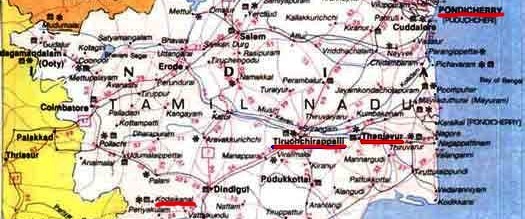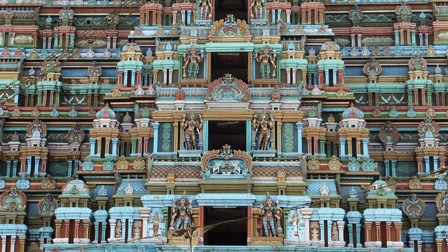|
February 6-8 2013 Tamil Temples in Trichy
and Tanjore
Just like Mamallapuram, we went to Trichy to see the temples. It also
made a good base to visit more temples in Tanjore, 50 km away. The
difference between the Trichy and Mamallapuram was immense. Mamallapuram
is a small town by the sea, full of tourists. Trichy is a large Tamil
town, far from the sea. It is crowded and dusty, but I liked it better
than Pondicherry. We were a distinct minority in Trichy. That meant
there were almost no touts selling souvenirs and we were a curiosity, to
be questioned politely by locals and asked to have our picture taken
with them. It also meant there were few tourist services, the wi-fi was
not working in our hotel and we could not locate an internet cafe
nearby.
We were pleased with the choice of our hotel.
Our room was good, the bathroom was a slight improvement, not
quite up to Canadian standards, but workable, and it was also close to
some of the temples we wanted to visit in Trichy. Thalassi, the in-house
restaurant owned by the recommended Banana Leaf chain, served
inexpensive and delicious Southern Indian vegetarian food. The chain is
not called Banana Leaf for nothing. Many of the meals are served on a
large banana leaf instead of a placemat and a plate. The leaf is clean
but you sprinkle water on the leaf to keep it moist and rid it of any
dust. Then rice is spooned
in the middle of the leaf and various side dishes are spooned around the
rice. The sauces are mixed into the rice and eaten with your right hand.
I am trying to master this technique but I am not very good at it so a
spoon and fork are given to us. Other dishes, such as a lunch time
thali, are served in a round tray lined with a banana leaf. Again, rice
or a Dosa or pakota (small chapatti) are placed in the middle and the
chutneys and sauces are placed in small round metal dishes around the
edge of the tray. Breakfast is the same type of food. I like the idlis,
a soft, round rice cake with sambal sauce,a soupy lentil curry. Ray
prefers a dosa with mixed vegetable curry. In case you are wondering,
there is always a sink and soap in the restaurant to wash your hands
before and after you eat. The manager, a young man from Delhi, spoke
perfect English and was kind enough to explain the different dishes to
us as well as help with our travel queries. We recommend the relatively
new Susee Park Hotel and the Thalassi restaurant.
We had taken the bus from Pondicherry on
Wednesday, February 8. It was not far as the crow flies but 180 km took
just over 5 hours and that was because much of the way was on a new toll
road. A young Dutch couple were the only other tourists on the bus. They
too ended up staying at Susee Park Hotel.
The Rock Fort and the Temple were built, perched
on the top of a gigantic rock, a landmark and lookout in the middle of
surrounding plains, by the Dayaks of Madurai centuries ago. Now it sits
in the middle of the busy commercial area of Trichy, close to our hotel.
Like all the Hindu and Buddhist temples, you must enter with bare feet.
That meant checking our shoes at the bottom of the hill and climbing 437
stairs to the Vinayaka Temple on top. There were several temples carved
into the rock at about the half way point. The biggest, Sri
Thayunmanaswamy, was open only to Hindus so we had to admire it from the
door. The second to last set of stairs opened onto a landing with a
great view of the city and a hazy view of the huge Sri Ranganathaswamy
Temple on the other side of the now very low Cauvery River. The main
Vinayaka Temple was still up a flight of candy striped stairs. We
weren’t the only ones there but it wasn’t crowded and foreigners were
definitely in the minority. The priests at Vinayaka were saying prayers
and giving puja spots to those who gave a donation. I put Rs10 in the
tray and got a white powder dot on my forehead and a rose to put in my
hair. I am accumulating good luck at all these temples.
After the heat of the day had dissipated later in
the afternoon we took a tuk-tuk to Sri Ranganathaswamy Temple, about 5
km from our hotel on the other side of the river. Lonely Planet calls it
more of a city than a single temple and it was. There were certainly
lots of destitute beggars at the gates and lots of Hindu souvenir shops
hoping to trade on the generosity of the visitors. There were also a few
processions of devotees coming to the temple, some with drums. The first
temple is the largest in India and there are 7 more stepped temples, all
in a row, that you must pass through to reach the temple’s inner
sanctum, dedicated to Shiva. After paying an admission charge for
ourselves and an extra charge for a camera we were directed up stairs to
a roof for the view. Only from there could you get the real scope of the
site. We continued on to the main temple at the end of the line. Several
small inner shrines were entered through a forest of carved stone
pillars, around which many worshippers were enjoying an afternoon nap.
We went one small temple with faded paintings that was being used as a
storeroom. It led to a yard used to tether cows, each with painted horns
and some with colourful designs painted onto their hides.
There is a second temple group, Sri
Jambukeshwara, on the same side of the river. We thought we could walk
there but got lost, despite getting directions from locals, decided it
was too far and not worth the effort. We took a tuk-tuk back to the
hotel.

Click
the photo above to see
an album of photos for Tanjore. Close the window to return to this page.
The easiest way to visit the temples in Tanjore
(Thanjavur), 50 km and one hour away, was to hire a car and driver for
the day. Road signs directed us to the Big Temple, Brihadishwara Temple
and Fort. A World Heritage site, it was started in the 9th century by
the Cholas who ruled their wide kingdom, which included Sri Lanka, from
Tanjore. Rajaraja Chola I (which means `king of kings`) built the
highest tower in 1010. The temple was later fortified by the Nayaks, a
skilled warrior dynasty from Madurai, who also built Rock Temple Fort in
Trichy. A huge 6m by 3m Nandi, carved from a single rock and weighing 25
tonnes. The main temple is dedicated to Shiva, whose mount is Nandi. The
walls surrounding the complex were lined with shrines, each with one or
several lingams, phallic figures that are the symbol of Shiva and
fertility. Several side shrines were busy with priests in attendance and
people making their daily devotions. I lined up to give another Rs 10
contribution and get my daily puja spot and a banana. Several bus loads
of students from Trichy were on a day visit. They were chatty but well
behaved and loved to ask our names and country of origin and to have
their photos taken.
We were followed by the busloads of students to
Thanjavur Royal Palace and Museums. They took up a lot of space in the
relatively small rooms of the palace and museums, but they didn’t linger
over the exhibits as we did. They were herded rather quickly by their
teachers and had only time enough to say Hi to us a second time.
The complex was constructed partly by the Nayaks
of Madurai and partly by the Marathas in 17th C. It is in the
process of a sorely needed refurbishment and consequently some of the
museums were closed. What we saw was enough anyway. The Library Museum
had an eclectic collection given by one of the Rajas that included a map
of world from Capt Cook dated 1795, botanical and anatomical illustrated
texts, and palm leaf religious texts. Another museum had a good
collection of stone figures from the 9th C up to the 18th
C while still another had many bronze figures of Hindu deities most as
old as the stone figures.
We had hoped to climb the stairs to see the view
from the top of the Bell Tower but changed our minds when asked for an
additional fee and told that you could only climb to the third floor. We
contented ourselves with the view from the roof of the palace, at the
base of a stepped tower covered in bamboo scaffolding. We stepped around
workers who were tearing up and relaying brick tiles on the roof and
peered up into the scaffolding to see more workers repairing and
cleaning the stone carvings before painting the whole tower with white
paint.
We had seen enough for one day. We drove back to
Trichy in time for a late lunch. We had intended to take an overnight
train to Mysore and visit a National Park not far from Mysore. Train
reservation for a berth proved to be unavailable so we have changed our
itinerary. We will take a bus to Kodaikanal in the Western Ghats to get
a little walking in the cooler climate of the hills. From there we will
have to decide how best to make our way to the Kerala coast and north to
Benaulim Beach in Goa by February 16. Flexibility is the key word in our
journey.
|


